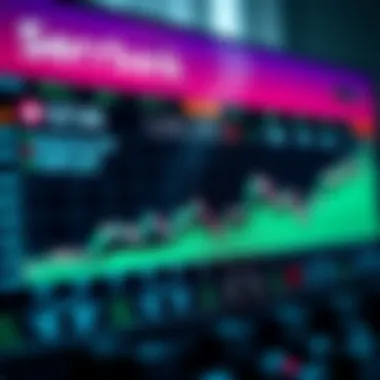Analyzing Sberbank Stock on the NYSE: Insights & Trends


Key Concepts and Definitions
Understanding the stock market can sometimes feel like navigating through a maze blindfolded. To make sense of Sberbank’s performance on the NYSE, it's crucial to grasp the lingo and underlying principles that inform investment decisions.
Overview of Investment Terms
When diving into the world of stocks, the following terms are indispensable:
- Ticker Symbol: Sberbank’s stock is traded under the ticker symbol SBRCY on the NYSE. Knowing this helps track its price movements and overall performance.
- EPS (Earnings Per Share): This figure gives an insight into a company's profitability on a per-share basis, something every investor keeps an eye on.
- Market Capitalization: This indicates the total market value of a company’s outstanding shares. For Sberbank, it reflects its size relative to other companies in the banking sector.
- Price-to-Earnings Ratio (P/E Ratio): A key metric in evaluating if a stock is overvalued or undervalued compared to its earnings. A lower P/E may suggest the stock is a better buy, given its earnings potential.
- Dividends: Regular payments made to shareholders, a critical aspect for those seeking income from their investments.
Significance of Understanding Financial Terminology
Without a solid grounding in these terms, assessing Sberbank's stock can be like reading a book in a foreign language. Grasping the nuances behind EPS, P/E ratios, and dividends enables investors to make informed choices. Knowledge about these terminologies can distinguish between panic selling and calculated decision-making when market fluctuations hit.
"The stock market is filled with individuals who know the price of everything, but the value of nothing." – Philip Fisher
Expert Insights and Advice
Once you've wrapped your head around the basics, it’s time to consider the strategies that can enhance your investment approach concerning Sberbank.
Investment Strategies for Beginners
For novice investors, beginning with a focus on Sberbank stock entails:
- Diversification: Avoid putting all your eggs in one basket. Investing in a range of sectors lowers risk.
- Dollar-Cost Averaging: Regularly investing a fixed amount can reduce the impact of volatility by averaging out purchase prices over time.
- Long-term Perspective: Patience can often yield better results than trying to time the market.
Advanced Techniques for Seasoned Investors
Jeremy over there with his experience suggests considering:
- Technical Analysis: Use charts and indicators to identify trends and make predictions based on historical data. This can add another layer to evaluating Sberbank.
- Options Trading: This involves contracts that give the right, but not the obligation, to buy or sell a stock. Familiarity with options can provide a strategic edge.
- Dividend Reinvestment Strategies: Instead of taking dividends as cash, reinvesting them can compound growth over time, particularly useful in banking stocks like Sberbank that have a history of paying dividends.
Prelims to Sberbank
Sberbank stands as a pillar in the global banking landscape, especially within the realm of Eastern Europe. This section is vital as it not only lays the groundwork for understanding Sberbank's financial dynamics but also highlights its substantial influence on the markets it operates in. By diving deeper into the core of Sberbank, investors gain a clearer view of what makes this institution tick, allowing for more informed investment decisions.
Overview of Sberbank
Sberbank, officially known as the Savings Bank of the Russian Federation, is the largest bank in Russia and Eastern Europe. Founded in 1841, it provides a myriad of financial services like traditional banking, insurance, and asset management. With over 14,000 branches, it boasts a sprawling network that reaches across cities and regions, making it an integral part of the Russian economy.
Key characteristics of Sberbank include:
- Market Leader: Holds a significant portion of the Russian banking market, often accounting for around 30% of all loans and deposits.
- Diversified Services: Offers a range of products, from retail banking to corporate finance, catering to varied customer needs.
- Technological Innovation: Embraces fintech, focusing on digital banking solutions that enhance customer experience.
This overview sets the stage for understanding not just the operational scale of Sberbank but also its potential impact on stock performance, as these facets can heavily influence investor sentiment and subsequent stock movements.
Historical Background
The journey of Sberbank is as rich as it is intricate. Established in the mid-19th century, it has weathered numerous geopolitical and economic changes, transforming considerably along the way. Originally, Sberbank catered primarily to the Russian populace by providing savings accounts, focusing on stability in a young and evolving market.
Through the tumultuous periods of the Russian Revolution and the Soviet era, Sberbank managed to adapt. By the time the Soviet Union disintegrated in 1991, it became a crucial player in reforming the banking sector anew. The challenges of the 1998 financial crisis forced Sberbank to restructure and recuperate efficiently, highlighting its resilience.
Over the last few decades, Sberbank has continued to evolve, merging with other banks and expanding its reach beyond Russia’s borders. Its successful listing on the New York Stock Exchange has brought new investors into the fold, solidifying its international presence.
In examining Sberbank's historical evolution, one cannot overlook how these formative experiences shape its current strategy and market competitiveness. Understanding this history provides essential context for evaluating its stock today and moving forward.
Sberbank's Listing on the NYSE
The inclusion of Sberbank on the New York Stock Exchange signifies a noteworthy stride for the bank and its international aspirations. This event not only allows Sberbank to tap into a broader pool of investors but also enhances its visibility in the global financial arena. As a major player in the Russian banking sector, its presence on the NYSE helps to cultivate trust among potential investors, who might be more inclined to invest in familiar stock markets like the NYSE rather than foreign exchanges.
Why is the NYSE listing important? Well, it elevates the bank's profile and brings more scrutiny to its operations. Investors often view companies listed on prominent exchanges as more stable and transparent. For Sberbank, this means attracting a wider range of institutional investors, which is crucial for long-term growth and stability.
Furthermore, the listing introduces Sberbank to a new set of regulations and compliance checks, aiming to align with international best practices, which could improve its operational framework and risk management protocols. This can lead to better corporate governance and a more robust financial footing.


So, Sberbank's listing isn't just a formality; it's a significant milestone that can influence a myriad of factors, from stock performance to strategic decisions in the years ahead.
Significance of NYSE Listing
The NYSE listing of Sberbank represents more than a mere step onto a prestigious exchange; it embodies a bridge to global markets for investors. This listing correlates to benefits that directly influence both Sberbank’s valuation and its operational strategies. Here are a few critical aspects:
- Access to Capital: The ability to raise funds directly through equity markets is invaluable. Sberbank can leverage its NYSE status to engage with US investors for capital needs or expansion projects.
- Global Reputation: Listing on NYSE implies a degree of intrinsic validation; it suggests that Sberbank meets strict requirements, enhancing its credibility globally. Investors often seek recognition from established markets to feel more secure in their investments.
- Increased Liquidity: Trading shares on the NYSE provides liquidity for investors. This aspect is vital, as it allows for easier buying and selling and could attract investment flows from those seeking stability and familiarity.
- International Visibility: When a stock trades on the NYSE, it garners attention on a global scale. Increased visibility can bring in analysts’ coverage, insights, and more informed opinions, further affecting investor sentiment positively.
- Benchmark for Performance: The NYSE serves as a performance benchmark for not just Sberbank but also other Russian entities, fostering competition and the pursuit of operational excellence.
In summation, these factors combined suggest that the NYSE listing is not only significant but essential for Sberbank's growth strategy and market positioning moving forward.
Timeline of Listing
Understanding the timeline of Sberbank's listing offers insights into the strategic decision-making process that led to this key event. Here’s a breakdown of the crucial milestones:
- Preparatory Stage (2016-2017): The groundwork began with discussions surrounding international expansion. Analysts cited favorable market conditions and an optimistic outlook for the banking sector.
- Announcement of the Intent to List (2019): In an official press release, Sberbank revealed plans to list its American Depositary Receipts (ADRs) on the NYSE. This highlighted the bank's intent to diversify its investor base.
- Regulatory Compliance (Early 2020): The bank undertook steps to meet the stringent regulatory requirements inherent to NYSE’s listing criteria.
- Successful Listing (August 2020): Sberbank's ADRs began trading on the NYSE, marking the commencement of a new chapter for the institution.
- Post-Listing Developments (Ongoing): Following the listing, Sberbank has focused on enhancing its transparency and reporting practices, aligning with international norms and expectations.
This timeline showcases significant efforts, reflecting Sberbank's commitment to expanding its reach and appealing to a larger segment of investors. With each step carefully measured, it underscores the strategic importance of entering such a high-profile marketplace as the NYSE.
Financial Performance
Understanding financial performance is crucial when assessing Sberbank's stock on the NYSE. This section of the article provides a lens into how the bank is faring financially, analyzing critical metrics. Investors rely on these metrics to determine the potential profitability and viability of the stock, making it an essential part of any thorough evaluation.
Key Financial Metrics
When it comes to evaluating a company's financial strength, there are a few key performance indicators that hold sway—namely, Revenue, Net Income, and Earnings Per Share. These metrics provide insight into not only how Sberbank earns its money but also how effectively it manages its resources.
Revenue
Sberbank's revenue is a fundamental metric that illustrates its total income from operations, excluding costs. A steady increase in revenue over time indicates a growing customer base and healthy demand for its services. This metric shows how well Sberbank is positioned in the market, with growing revenue often attracting investor interest. The unique feature of revenue is that it reflects the bank’s capacity to grow and expand without necessarily considering the expenses involved. While rising revenue is a beneficial sign for investors, it's important to consider how profit margins vary. Increasing revenue doesn’t always equate to greater profitability if costs also escalate.
Net Income
Net income paints a broader picture, revealing what remains after all expenses, taxes, and costs are deducted from total revenue. This metric is key because it allows investors to gauge Sberbank's actual profitability. A high net income indicates efficiency and effective management. What makes net income particularly appealing is its effect on retention and reinvestment strategies. This profit can be reinvested for future growth or distributed as dividends to shareholders. However, investors must also keep an eye on the underlying factors that might affect net income, such as economic conditions or regulatory changes.
Earnings Per Share
Earnings per share, or EPS, measures a company’s profit allocated to each outstanding share of common stock. This metric is often seen as a direct measure of profitability on a per-share basis. High EPS can be a strong indicator of financial health and is often used in relative valuations with other companies in the sector. The defining characteristic of EPS is its straightforwardness—it provides a clear figure that investors can compare against peers to gauge performance standards. While it’s a potent metric, it can be misleading if companies manipulate public perceptions through share buybacks or other tactics aimed at boosting EPS artificially.
Quarterly Trends
Analyzing quarterly trends helps investors understand how Sberbank is performing over shorter time frames. Identifying seasonal fluctuations and cyclical patterns can provide clues to future earnings potential. This trend analysis highlights how Sberbank adapts to market conditions and demographic shifts, allowing investors to stay ahead of the game.
In coming quarters, should Sberbank continue to deliver solid metrics, it could bolster investor confidence, while any shortfall might prompt a reevaluation of risk associated with holding the stock. Investors need to keep an eagle eye on these trends, as they directly influence trading decisions in a marketplace that can be as volatile as it is promising.
Market Dynamics
Understanding the dynamics of the market around Sberbank's stock is crucial for any investor keen on navigating its complexities. These dynamics encompass stock price fluctuations and trading volumes, both of which can offer insight into the bank's performance on the NYSE. By grasping these elements, investors can better assess risk and opportunity for growth.
Stock Price Fluctuations
Stock price fluctuations are a critical aspect of Sberbank's market standing. The price of Sberbank’s shares is influenced by various external and internal factors.
- Earnings Reports: Quarterly earnings can lead to dramatic shifts in stock prices. Positive earnings often encourage bullish sentiments, driving prices upwards. Conversely, disappointing results can cause unexpected drops.
- Geopolitical Events: Given the bank's ties to the Russian economy, geopolitical tensions can lead to volatility. For instance, sanctions can create uncertainty, leading investors to re-evaluate their positions.
- Market Sentiment: The current mood of the market often influences Sberbank's stock prices. If there’s an overall bearish trend within financial markets, even fundamentally strong stocks can suffer.
These fluctuations can create both risk and opportunity for investors. An astute investor might look for undervalued stocks during downturns, seeing potential where others may only see risk.
Trading Volume Analysis
Trading volume serves as a barometer for investor interest and market sentiment. When Sberbank’s stock experiences high trading volume, it indicates strong investor activity, a signal that could either support a prevailing trend or signify a shift in momentum.
- High Volume Days: If there are spikes in trading volume, it may result from new information or major announcements impacting Sberbank directly. Analysts often suggest that high volume during price increases signals a solid trend, as many investors are buying shares at the same time.
- Low Volume Context: Conversely, low trading volume might indicate a lack of interest or uncertainty, suggesting that investors are waiting for more clarity before making moves. This can act as a warning sign to potential investors.
It’s important to combine trading volume analysis with other metrics for a clearer picture of Sberbank’s stock performance. High volume alone doesn’t guarantee a price increase but does highlight the level of interest surrounding the stock.


Epilogue
For further reading on market trends and stock analysis, consider visiting Investopedia or detailed reports found on Yahoo Finance. Also, resources like Wikipedia can offer foundational knowledge on Sberbank’s history and development.
Factors Influencing Sberbank Stock
Understanding the factors influencing Sberbank stock offers invaluable insight for investors. The stock market isn't just driven by numbers on a balance sheet; it's a living entity, swayed by numerous external forces. This section delves into key influences—from geopolitical dynamics to economic indicators. Each element carries weight in determining the contour of Sberbank's stock trajectory, thus shaping investment outcomes.
Geopolitical Influences
Geopolitical tensions can send ripples through global financial markets, Sberbank included. Its performance often mirrors the stability or turbulence of Russia's political landscape, especially considering the bank's significant role in the Russian economy. When international relations fray, say due to sanctions or diplomatic disputes, Sberbank's stock might respond negatively—investors pulling back due to uncertainty.
Recent geopolitical events, particularly involving Ukraine, illustrate this volatility. Investors watch closely as sanctions imposed by Western nations can affect the bank's operations and market perception. In addition, decisions made in capital markets can create a cascading effect, influencing local and foreign investments alike. Hence, geopolitical factors are vital to assess for anyone contemplating an investment in Sberbank stock.
Economic Indicators
Economic indicators provide the lens through which we can anticipate Sberbank's stock movements. They encompass a range of metrics that describe the health of the economy, impacting consumer behavior and lending practices.
Inflation Rates
Inflation is like a double-edged sword in the financial world. It affects purchasing power and, subsequently, consumer behavior. High inflation rates can dampen economic growth as consumers tighten their belts. For Sberbank, this means less demand for loans and banking services, ultimately impacting revenue. Moreover, if inflation rates don't align with the bank's interest rate settings, profit margins might squeeze further.
Investors must keep a keen eye on inflation trends and projections. Understanding how price stability relates to Sberbank can illuminate potential investment risks. While moderate inflation might indicate a growing economy, soaring inflation signals economic strain, prompting caution among investors.
Interest Rates
Interest rates play a pivotal role in the banking sector, affecting everything from loan costs to investment yields. An uptick in interest rates typically signals an effort to curb inflation, which in turn can influence borrowing behaviors. Higher rates often lead to reduced loan demand, impacting Sberbank’s profitability.
Conversely, lower interest rates can spur borrowing and spending, generally favoring banks like Sberbank.
"Interest rates are the lifeblood of lending; too high or too low, and the balance shifts dramatically in a bank's favor or against it."
The unique feature of interest rates lies in their influence on consumer confidence. When rates are stabilized or low, consumers feel bolder to invest and take loans, boosting a bank's stock. Investors must recognize the ongoing adjustments in interest rates and grasp their potential impact on Sberbank’s performance and overall strategic direction.
In summary, both geopolitical influences and economic indicators are critical in shaping Sberbank's stock values. Investors ought to approach these themes with holistic scrutiny, understanding that each represents a piece of the broader financial landscape.
Competitive Landscape
Understanding the competitive landscape surrounding Sberbank is vital for investors looking to grasp the broader banking sector in which it operates. The competition provides context for Sberbank's strategies, market position, and overall performance. It offers insight into how effectively the bank can leverage its resources against peers, thus influencing its stock price and long-term viability. Examining the competitive dynamics not only elucidates Sberbank’s standing among its rivals but also informs potential investors about the risks and opportunities in the current marketplace.
Comparison with Other Banks
When evaluating Sberbank in comparison with other banks, several key aspects come into play. Major competitors include VTB Bank, Gazprombank, and foreign banks like HSBC and Citigroup. Each bank has unique strengths and weaknesses that can affect their respective standings.
- Market Reach: Sberbank has an extensive branch network primarily in Russia, making it a leader in retail banking services. In contrast, HSBC has a significant presence in multiple countries which provides it with diversified revenue streams.
- Technological Advancements: Sberbank has made notable investments in digital banking technology, optimizing customer experience and operational efficiency. Other banks, especially those in emerging markets, may be slower to adopt similar technologies.
- Financial Health Metrics: Investors often turn to metrics like return on equity (ROE), net interest margin, and cost-to-income ratio when making comparisons. For instance, while Sberbank often demonstrates robust ROE, banks like Citigroup may show higher asset bases but lower margins.
"The competitive landscape is not merely a backdrop; it shapes decisions at every level, impacting stock performance and investor confidence."
Market Share Analysis
The market share analysis of Sberbank reveals its dominance in the Russian banking sector while highlighting potential challenges regionally and globally. According to reports, Sberbank holds approximately 30% of total banking assets in Russia:
- Retail Banking: Sberbank leads the market with around 45% of retail deposits, showcasing strong brand loyalty and consumer trust.
- Corporate Banking: In corporate segments, the bank competes fiercely with VTB, which holds a significant share of state-owned enterprises, further complicating the competitive scenario for Sberbank.
- Emerging Competition: The rise of fintech companies is increasingly threatening traditional banks. Startups focusing on mobile banking and personal finance management have started to capture younger demographics, prompting established banks like Sberbank to innovate rapidly.
In summary, a clear understanding of the competitive landscape, including both direct competitors and emerging forces, provides critical context for investors. Not only does this enhance the understanding of Sberbank's market performance, but it also aids in identifying potential growth avenues and risks that might impact investment decisions.
Investor Sentiment
Understanding investor sentiment is critical when it comes to assessing stocks like Sberbank on the NYSE. It represents the overall attitude of investors toward the bank’s stock, influencing buying and selling decisions. This sentiment can be shaped by various factors including recent financial performance, broader market trends, and geopolitical occurrences.
When the mood is generally optimistic, investors are more likely to purchase shares, driving up Sberbank’s stock price. Conversely, negative sentiment can trigger a wave of selling, creating downward pressure. Several key components contribute to how sentiment shifts:
- News and events: Announcements regarding Sberbank’s strategy, earnings reports, or changes in regulations can quickly alter investor outlook.
- Macro-economic conditions: Conditions like inflation rates and interest rates play a substantial role in shaping sentiment among retail investors and analysts alike.
- Social media and forums: Digital platforms like Reddit or financial news websites offer a space for investors to share opinions or insights about Sberbank, and this grassroots discussion can significantly affect market dynamics.


Furthermore, sentiment analysis can provide insight into potential market reactions. For instance, if a majority of investor commentary on social media platforms leans positive, analysts might predict that Sberbank’s stock will see a rally in the near term. Alternatively, if chatter is dominated by concerns, it could imply a forthcoming drop.
"The pulse of investor sentiment can sometimes overshadow fundamental financial performance, resulting in significant mispricing in the stock market."
To summarize, investor sentiment isn't just fluff; it's a powerful force that can sway Sberbank's pricing and trading patterns, making it a crucial area of focus in any comprehensive analysis.
Market Analyst Perspectives
Market analysts bring a wealth of experience and quantitative methods to their evaluations of Sberbank. Their perspectives provide a deeper understanding based not only on the bank’s historical performance but also on projections for its future growth. Analysts typically use several benchmarks and metrics to formulate opinions:
- P/E ratio comparisons: How does Sberbank's price-to-earnings ratio stack up against competitors like VTB Bank or Gazprombank? A lower ratio might indicate that the stock is undervalued.
- Growth forecasts: Analysts analyze trends to provide estimates about Sberbank’s growth in revenue and earnings. These projections serve as a guide for investors.
- Equity research reports: Regularly published insights and reports provide updated information on price targets and whether to buy, hold or sell Sberbank stock.
In essence, investors should pay attention to changes in these analysts’ ratings. A shift from a buy to hold rating, for example, could signal a cautionary note to investors possibly expecting a market adjustment.
Retail Investor Trends
Retail investors have been increasingly engaged in equity markets, and their trends are particularly telling when it comes to Sberbank. Unlike institutional investors, retail investors may react more emotionally to news, making their collective behavior a fascinating subject of study.
Some patterns observed include:
- Social media influence: With platforms like Twitter and Facebook, retail investors share insights and experiences, impacting their collective behavior dramatically. Posts that go viral regarding Sberbank can lead to spikes in trading volumes.
- Response to economic indicators: Retail investor trading often correlates closely with major economic news. For instance, higher inflation rates or political instability might lead to increased selling activity among these investors.
- Trend-following behavior: Many retail investors may jump on a stock when they see upward momentum, contrasting their likely exit during downturns. This trend-chasing approach can lead to volatile stock movements.
Considering the retail investor sentiment toward Sberbank can yield insights about broader market conditions. Retail contributions to trading volume can amplify price movements, which could either stabilize or destabilize the stock.
In summary, the sentiment of both market analysts and retail investors presents an intricate tapestry that influences Sberbank’s stock performance. By taking into account these perspectives and trends, investors can develop a more informed strategy for navigating the complexities of the market.
Future Outlook
The future outlook for Sberbank stock carries substantial weight for investors eyeing the banking sector, particularly in light of shifting economic landscapes. An informed forecast not only helps in understanding potential returns but also unveils the myriad factors that could sway market performance. While past achievements are noteworthy, the focus must shift toward how Sberbank can position itself in an ever-evolving financial environment.
Projected Growth
Projecting growth for Sberbank involves a multi-faceted approach. Analysts often look towards macroeconomic indicators as well as the bank's internal strategies. For instance, expectations of increasing consumer and business lending can point toward enhanced revenue. In addition, with Russia’s economy gradually rebounding from various sanctions, Sberbank may be well-poised to capitalize on demand in the financial services sector.
Moreover, further digitalization efforts could bolster Sberbank’s standing among tech-savvy younger consumers. The recent push for advanced banking solutions, such as mobile apps and AI-driven customer service, yields a potential upswing in user engagement. Investors should also keep an eye on international expansion plans, as entering new markets might provide a needed boost to their market share and profitability.
"Growth isn't just about figures; it’s about fostering trust and building a solid reputation that can weather storms."
In terms of hard numbers, analysts might predict a steady GDP growth rate of around 1.5-2.0% over the next few years—this could translate to a similar uplift in Sberbank's stock price if executed well.
Potential Risks
Despite the optimistic projections, potential risks loom large, making caution equally important for investors. One pressing concern is the ongoing geopolitical tensions, notably surrounding sanctions. These can affect the bank's operational capabilities and market access directly, sometimes in unexpected ways. For example, changes in policy from major economies can create ripple effects, causing Sberbank stock to experience significant volatility.
Additionally, unexpected inflation rates can strain the lending environment. If inflation continues to climb, as seen in recent months, borrowing costs might rise, potentially leading to reduced loan demand. This could adversely affect Sberbank’s revenue trajectories.
Furthermore, heightened competition from fintech firms and smaller banks poses another risk. If Sberbank fails to keep up with technological advancements or customer service expectations, it may lose market dominance. Investors ought to monitor these external pressures and internal responses closely.
In summary, while the future outlook for Sberbank stock appears cautiously optimistic, an array of variables will undoubtedly shape its trajectory. Investors must balance their aspirations with an awareness of the potential hazards, ensuring their decisions are grounded in comprehensive analysis.
Ending
The exploration of Sberbank stock listed on the NYSE reveals various dimensions worth understanding for anyone keen on investment dynamics. This article not only touches upon financial metrics but also dives into the intricacies of geopolitical matters, competitive landscapes, and investor sentiments. The significance of this conclusion is profound, as it encapsulates the essence of what makes Sberbank a unique player in the banking sector.
Summary of Key Findings
Throughout the course of this article, several critical points emerged regarding Sberbank's standing on the NYSE:
- Stable Financial Health: Sberbank showcases a strong balance sheet, with robust revenue and earnings growth over the past few quarters.
- Geopolitical Influence: The Russian bank's performance is heavily influenced by geopolitical events, which can affect investor confidence and market stability.
"Monitoring global tensions is key for understanding shifts in Sberbank's stock price."
- Investors' Perspectives: Market analysts and retail investors display varied sentiments. While many look for long-term holding opportunities, the volatility observed in stock prices can deter some investors.
- Comparative Performance: When measured against peers in the banking sector, Sberbank holds a notable market share but faces stiff competition both locally and globally.
Investment Considerations
When contemplating an investment in Sberbank, several factors should be taken into account:
- Understand the Risks: With its services spanning across numerous spheres, recognition of broader market risks, including international sanctions and currency fluctuations, is imperative.
- Growth Potential: The bank has plans to expand its digital services and technological infrastructure. Keeping an eye on such initiatives could reveal future stock performance.
- Long-term versus Short-term: Investors need to decide if their interest lies in short-term gains based on price fluctuations or long-term growth stemming from Sberbank's strategic vision.
- Regulatory Environment: Given that Sberbank operates within a heavily regulated financial sector influenced by government policies, awareness of upcoming regulatory changes is crucial.
- Global Markets Impact: The interconnected nature of global financial systems implies that any significant event elsewhere can impact Sberbank positively or negatively, warranting close observation.
In summation, understanding the facets of Sberbank's operations on the NYSE requires more than just a glance at stock prices. It necessitates a comprehensive analysis of both financial indicators and external factors. Investors equipped with this nuanced understanding can navigate the complexities of investing in a stock as multifaceted as Sberbank.















